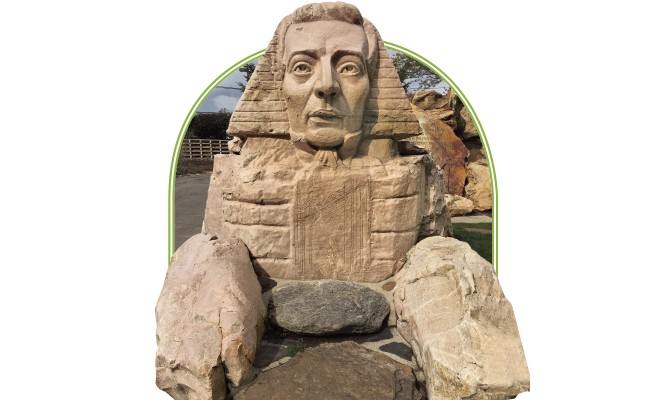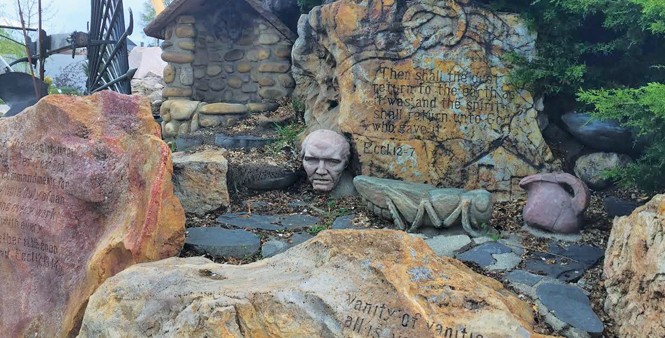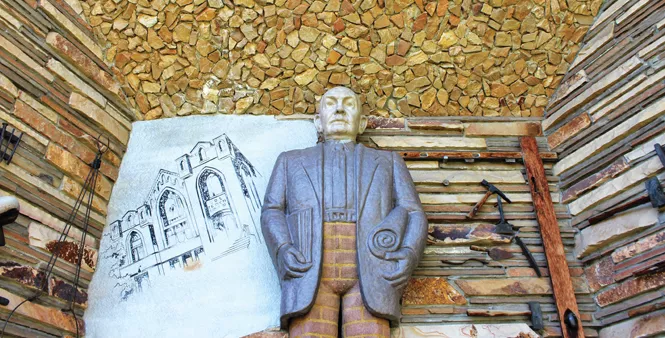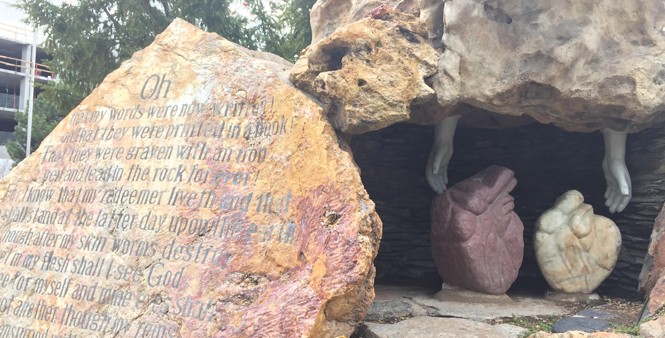Save Our Sphinx!
17 years into its run as a public park, Gilgal Garden is starting to show its age.
By Dylan Woolf Harris @dylantheharrisOne night in the fall of 1977, University of Utah work-study student Lynn Curt and his pal needed a spot to pound some beer. Curt had moved to town from the Midwest, and his new friend invited him to hang out, as well as check out "a weird place" that he was assured, "'you're going to like.'"
Curt says he arrived at the given address and despite the home being boarded up, he knocked on the door. A voice from within called out that Curt would have to come around back.
His friend and others, he soon learned, were squatting there. But the abandoned home wasn't the beer-drinking destination Curt's friend had hinted at.
To get to that spot, they snuck past some nearby houses into an overgrown plot in the middle of a neighborhood block at a mischievously late hour. To hear Curt describe it, their destination resembled a scene from gothic lore. The grounds were overrun with scruffy vegetation. Along a side wall, vagrants were sleeping among twiggy tree branches in makeshift structures. But the most memorable features were the stone carvings—solid visages staring blankly in the moonlight.
"It was spooky," Curt reminisces.
Odd as it sounds, Curt's early foray into what is now known as the Gilgal Sculpture Garden is not entirely unique. A man strolling through recently remarked that decades ago, he hopped a fence one night into the garden—which sits on a plot of land in the block between 400 and 500 South; 700 and 800 East. The area had completely transformed, he says.
Prior to 2000, it seems Gilgal was for the adventurous—an eerie, verdant secret that you'd consider skulking through on a lark. The relatively unknown treasure was invisible to much of the city, which was growing and morphing around it.
Those secret garden days are long gone. The space appears on "quirky things to see in Utah" lists, including a blurb in a worldwide compendium published by Atlas Obscura. Now a pleasant public park, Gilgal openly welcomes all to marvel at the artistry of Thomas Battersby Child Jr. and Maurice Edmund Brooks. Child, a mason by trade, a devout Mormon by creed and an all-around visionary, was the garden's architect. Brooks was the sculptor who helped Child realize his concepts by spalling and shaping the rocks with an oxygen acetylene torch.
Child began working on the garden in 1945, and continued until his death in 1963.
The grounds might have remained closed to the public—or, more drastic yet, been lost to land developers—if not for a nonprofit group that calls itself Friends of Gilgal Garden, as well as a local gardening association that has a few overlapping members.
From its inception, Friends of Gilgal Garden's mission was to preserve the park. (Curt, now a board member, jokingly says he's serving penance for trespassing into the space as a young man.) The first step in saving the garden as a public park occurred when the Friends formed before the turn of the century—around the time City Weekly ran a November 1999 cover story on the group's efforts. They organized an ambitious fundraising campaign that was helped by notable locals, including Republican Sen. Orrin Hatch, the Deseret Management Corporation and Salt Lake County.
And the public came through.
The Church of Jesus Christ of Latter-day Saints Foundation, as well as the George S. and Dolores Doré Eccles Foundation, were among the many donors who helped secure the capital to open up the sui generis garden to the public.
BROKEN FINGERS, KEPT PROMISES
Today, Friends of Gilgal Garden welcomes donations for gardening projects and to cover the repair costs for damaged statues and stones. The nonprofit's tax forms indicate the group raised just over $12,000 last fiscal year. The total includes about $5,000 from the county's Zoo, Arts and Parks (ZAP) budget.
Members don't actively solicit funds, but co-president Judi Short says visitors who are mesmerized by the stones and statues on occasion slip money to a gardener to put toward the donation rather than send it to the post office box listed in the information box near the tiny park's entrance. A sizable portion of the funds, she says, goes into beautifying the gardens.
Once a week, volunteer members of the Salt Lake County Master Gardening Association serve as curators of the grounds' flora. The inclusion of the word "master" in their organization's title is a touchy subject. Out of habit, perhaps, members continue to use that verbiage, and it's still on their signs and pamphlets. But officially, due to a splintering from an official Utah State University group, they aren't supposed to call themselves a master gardeners association, they say.
On a recent Tuesday, five gardeners trimmed spent flower tops—a grooming technique called "deadheading." Short—who in addition to being co-president of the Friends of Gilgal Garden, is also a member of the gardening association—pruned twisted branches from a buckthorn tree trunk. The tree's columns looked like haphazardly braided hair.
"There's stuff like that," she says, holding up a dry, brittle stick. "It's deader than a doornail." When the trunks get too thick with branches, she says, it's difficult for anything underneath to grow.
In the next week, they're expecting a shipment of new bark. When spread on the dirt, it inhibits weeds, holds water in and fertilizes the soil as the bark breaks down. The weekly jobs, the gardeners will tell you, are standard; other than recruiting new members, it's not that difficult of a gig.
Gardening is one thing that this group has mastered, regardless of what they're called. But caring for and protecting the statues is another beast.
Arguably, the most iconic piece in Gilgal Garden is a sphinx with LDS church founder Joseph Smith's face. His resolute mug is positioned under hair fit for an Egyptian deity. His body is animalistic, but roughly shaped and impressionistic. His chest is in the form of a block wall, decorated with five-point stars.
Observers will also notice a crack marring the structure, running through the sphinx's mouth and continuing across his cheek like a vile knife gash. Another chunk of stone has been crumbling from his shirt collar.
Curt says the Friends of Gilgal have hired a stone restorer in the past to mend the broken bits.
Signs ask visitors not to climb on the statues, though many still do. The park has experienced malicious vandalism, as well.
Take, for example, a piece titled "Malachi." Its symbolism speaks to a sacred tenet of Mormon faith, depicting the eternal bond families are promised if they act righteously and follow God's commandments. Inside the mouth of the cave, two hands hang down like stalactites corralling two hearts. In the original piece, one hand was white and the other red, as were the hearts.
Curt says Friends showed up one morning and noticed that the fingers from one of the hands had been broken off. About a week later, the other hand was completely missing. Fortunately, an original was safe in storage—the only one in existence—and the group hired a sculptor to create a cast and mold two replicas, though they are now both white.
It's unlikely the fingers will be severed from the new hands, which are made with sturdy, reinforced fiberglass. "You can hit on it with a sledgehammer," Curt says. "It might come off of the ceiling, but you're not going to damage it."
Then there's the clues—bits of evidence—that people are entering the park after hours, which the Friends try to clean up when they see it. They've gathered prayer candles, cleared stacks of rocks, and awakened people sleeping under an awning (officially, the park is open from 8 a.m.-8 p.m. daily, though the main gate is usually unlocked from sunrise to sunset). One time, Curt says, he made it to the park early in the morning, and was startled to find the sculpted bust of Child's wife, Bertha, wearing sunglasses placed on her nose.
"The swords [in the Monument to Peace exhibit] have been stolen; we've had to replace those," he adds. "There's been a couple things busted, but we can get a welder here to fix. Not much graffiti."
WHAT THEY'RE SAVING
Friends of Gilgal Garden encourages city dwellers to stop by if they haven't yet. Visitors can see the park's main attractions in less than 30 minutes, or stay for several hours if they want to delve into the inscriptions.
After entering the park through a 6-foot-high, black wrought-iron fence, a 100-foot tree-lined walkway leads visitors into the center of the park. But before you get there, an open plot on the right with a newly mulched floor offers benches for rest under leafy trees.
Once inside, visitors around this time of year will notice bushes of pink, white and red roses next to a massive boulder engraved with the word "Gilgal"—a Biblical term said to mean "circle of sacred stones."
The sphinx is on the right. As you approach, you'll pass what's called "The Altar." Two items sit on long stone slates, which were gathered from Wayne County. A cylindrical furnace occupies one side, and a huge bowl is on the other.
An imposing structure to the left is known as "Captain of the Lord's Host." A giant human figure from the neck down is carved into a vertical stone. The man is holding a sword downward. His head, however, is unaltered rock. When asked whether he had plans to carve it, Child reportedly responded, "No, I intend to leave it as it is, thereby taking advantage of the liberties of modern art," a Gilgal pamphlet states. "The nature of this monument does not require accuracy ... It is sometimes more potent to suggest and cause wonderment than to explain in detail."
On the back is a plaque with a list of names—including Queen Victoria—who the piece is "dedicated in loving remembrance to."
If you enter the grassy area to the right past the Smith sphinx, you'll notice an exhibit east of the willow tree titled "Monument to the Trade." At the center of the monument is a statue of Child wearing brick pants—a symbol of his Masonic foundation. On the walls that flank him hang tools made of wood and metal. A rocky roof slopes over the scene.
Facing the monument, your back is turned to a mound that contains several pieces; a cornucopia of unique features. One side has an arrangement of metal hooks and spears and swords called "The Monument to Peace." Stone body parts are strewn on the back slope and a cricket on another, which is part of a piece titled "The Last Chapter of the Book of Ecclesiastes."
The east lawn is lined with a vertical key-shaped column, the tallest piece in the park, atop of which is a metal wire Captain Moroni figure, similar to what you'd find standing on the spire of a Mormon temple, blowing a horn.
Next to the key is a boulder archway called "The Monument to the Priesthood." The keystone is engraved with the letters "AO." And next to that is a stack of three giant books. The gardeners say Child intended to place a rock globe on the books. A rounded stone that was to become the globe is on the premises as well.
Farther back, two spacious, multi-door bird houses rest on poles jutting skyward.
Not all the art was created by Child and Brooks. Three sculpted eagles, meant to symbolize patriotism, were gathered from a former railroad station, Curt says. The Friends constructed stands for the birds to sit on.
The group has compiled a pamphlet that is free to visitors, which describes the major features at the park and explains their significance.
Recognizing his own oeuvre as strange but alluring, Child was spiritual and serious and he didn't mind challenging pieces. "You don't have to agree with me," reads a quote from him on the Gilgal website. "You may think I am a nut, but I hope I have aroused your thinking and curiosity."
The work of his partner, Brooks, though more conventional, is also admired around town. He helped sculpt pieces outside the Utah State Capitol, for instance, such as the Mormon Battalion Monument, according to a local anthology titled Utah Art Artists.
FOR THE RECORD
Although the Friends of Gilgal offers a pamphlet that guides visitors through the garden's main attractions, there isn't enough room to document each stone and engraving. For that information, you'd need to talk to Chelsey Zamir, a public historian and recent master's degree graduate from the University of Utah.
Zamir was contracted to document each floor stone, carving and engraved rock. She measured the dimensions—width, length, height—as best she could, though many of the stones are oddly shaped. Moreover, the carvings that represent body parts, such as the feet and hands on the north face of the park's prominent mound, have more facets that one could feasibly break down.
"Obviously, some of them are round and others you can't get around," she says.
On the more than 70 stepping stones with engraved quotes, Zamir measured the height of the letters in each inscription.
She compiled the data in a spreadsheet, linked a photograph of each rock or structure and drafted a crude, color-coded hand-drawn map, which she says could serve as the framework for a professional version. "I tried my best to document even the pathway stones through the backside of the garden—the paths, the benches and trees."
Zamir also took note of which stones and sculptures were damaged or worn.
The erosion is especially evident on well-trodden floor stones, as well as the main sculptures, which despite signs forbidding climbing, sometimes are props for impromptu photoshoots.
Zamir says it's difficult to determine whether the cracks in the stones are from wear-and-tear wrought by visitors, or merely a symptom of weather and time. In any event, she says, it's best to preserve the statues while they're in relatively good shape.
In her research, Zamir broke down the features into three categories: sculptures and bigger structures (~18), floor stones (~70), and stones that stood out of the ground (~32). She also attempted to cite the sources for all the engravings, which she says was the "easiest part" of the project with the aid of Google and lds.org.
Some of the words on two of the larger stones have already faded, however. Zamir was able to track down the quotes, but she can't be certain that Child recorded them on the rock verbatim.
"He did misspell some words, as you're likely to do," she says. He also modified quotes on occasion.
She estimates that she put in about eight hours a week, starting mid-January and wrapped up the project in June. Now it's up to the folks running Gilgal Garden to determine what they do with her information.
Friends of Gilgal Garden member Lisa Thompson says the documentation will be invaluable if any of the art in the garden is further damaged, and it will help the organization preserve the pieces for decades to come.
"To do this, we need an accurate inventory of all the elements in the garden and their current condition," she says via email. "Over the decades since Thomas Child created the garden, some of the lettering on the paving stones has started to erode away and become difficult to read. Some of the paving stones have cracked. Vandals occasionally damage or remove pieces from the garden.
"The extensive photos, measurements and records of the lettering on each stone Chelsey compiled this spring will help Friends of Gilgal Garden identify pieces at risk and plan for appropriate preservation projects," Thompson continues.
EARLY THREATS
Eighteen years ago, Curt sat in a coffee shop, perusing a copy of City Weekly. He stopped at the cover story, which detailed the Friends of Gilgal Garden's push to preserve a quirky park. It struck him as he read that this space, Gilgal, was the very place he snuck into years ago, a spot he hadn't thought about much since. "As I looked at the cover, I thought this all looks familiar, and it brought back memories," he says.
At that time, neighbors were concerned that the property would be incorporated into a new commercial or residential zone, and then developed.
Friends of Gilgal Garden organized at a time when the fate of the park was up in the air.
In those days, the property owners, the Fetzers, weren't sure what to do with the land. Maintaining the strange garden had become burdensome, and strangers who snuck in at night posed liability concerns. As the Fetzers aged, and they continued to pay property taxes, they looked into selling. Gary Fetzer determined the family would hold off putting the property on the market in order to give the Friends a chance to help raise enough funds.
"It's got some unique things about it," he was quoted as saying in CW. "But, like anything else, is the public willing to pay for it?"
The vision was to treat the park as a museum, where groups could host events and discuss art.
Not long after reading the article—as the city prepared to acquire the land for park space—Curt, a surveyor, was tasked with delineating the boundary and mapping its features. "There were so many property line issues and different deeds that it turned out to be a quite complex project," he recalls. The city swapped pieces of land with neighbors.
"This went on for a long time, and there are still two properties that could do a boundary-line agreement with the city to better fit the park's occupation," he says. "I would like to see that happen as our intent is to get a conservation easement put over the garden and add a layer of protection to the property. This contiguous boundary is required for that to happen."
The Salt Lake City Parks & Public Lands Department mows the grass, but general upkeep is mostly in the hands of the Friends and gardeners. There are some in the group, Short says, who think the city should allocate more resources for the park.
Before it switched ownership, Fetzer warned about public-private complications. "We wanted to preserve it, not destroy it. But it either needs to be 100 percent public or 100 percent private, or it won't work," he said at the time.
Curt says transferring stewardship to a conservancy group would clear up any questions of responsibility.
SOLITUDE
"It's a very peaceful place," Short says. "Except when they're building next door." Forty-five feet from the fence, a towering apartment complex threatens to block out the western sky. The familiar sounds of construction resonate as she speaks.
Visitors tell the garden club that they want to see the features they'd read about online. Or they want to return to a place they remembered experiencing during their youth. Or they simply want solitude—a quick escape from the city without the need to drive long distances.
On a June afternoon, as the temperature creeps oppressively close to triple digits, the park is empty, save for two bodies. A lithe man does sit-ups on the grassy west quarters, while another lies face-down on a sleeping bag spread out on the cement under a covered carport. Nearby construction has paused on this day—for this moment, at least. There are no clouds to provide respite from the sun and no hint of a breeze. The park is hot and still.
Like the man on the lawn, the Joseph Smith sphinx basks in the unrelenting heat.
Motivated by nothing other than preserving the slice of Utah quirk for future generations, Friends of Gilgal Garden hope the features will withstand the elements.
"Anything we can preserve and maintain for the future is a good idea," Zamir says, adding, "There was a time when the garden almost got demolished. People worked really hard to maintain it and keep it alive."
More by Dylan Woolf Harris
-
Dabakis Is Leaving the Building
Ever boisterous and outspoken, state senator says lending liberal voice trumps his bill tally.
- Apr 4, 2018
-
Gagged and Bound
Row between South Salt Lake and muralist gets the burlesque treatment.
- Mar 21, 2018
-
Inland Port Authority Update
Gov. Herbert signs contested bill into law.
- Mar 16, 2018
- More »
Latest in Cover Story
Readers also liked…
-
Forget the family pedigree—Robert F. Kennedy Jr should not be the next president of the United States
Trojan Horse
- Jun 21, 2023
-
Women decry harassment and toxic culture at St. George auto dealership
Men at Work
- Oct 11, 2023










